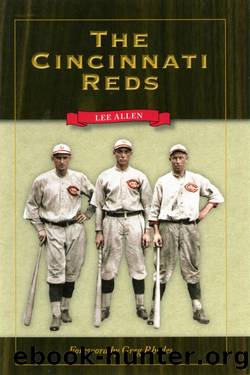The Cincinnati Reds by Lee Allen

Author:Lee Allen
Language: eng
Format: epub
Publisher: The Kent State University Press
3
The moratorium on the trading of Groh was lifted, and in December 1921 Garry Herrmann shipped the star third baseman to the Giants, receiving in return a package of cash estimated at $100,000 and a thirty-one-year-old outfielder, George Burns. The gaping hole at third base caused by Heinieâs departure was believed filled when the club sent the fading Hod Eller, another pitcher named Lynn Brenton, and cash to Oakland of the Pacific Coast League for a young guardian of the hot corner named Ralph (Babe) Pinelli. Another youngster from San Francisco, shortstop Jimmy Caveney, was secured in a deal for pitchers Fritz Coumbe and Bob Geary, and $25,000. With Caveney on hand, shortstop Larry Kopf and pitcher Rube Marquard were peddled to Boston for pitcher Jack Scott. Thus the Reds had developed almost an entire new infield in the two years that had elapsed after the championship. Jake Daubert, at first, was now thirty-seven, but the other infielders were kidsâSammy Bohne was twenty-five, Lew Fonseca twenty-three, Jimmy Caveney twenty-five, and Babe Pinelli twenty-five. All of them had graduated to the Reds from the Pacific Coast, a region that was by now producing ballplayers in profusion.
Another valuable addition to the 1922 team was George Harper, a hard-hitting outfielder bought from Oklahoma City. He was not quite thirty, and had had a previous trial with Detroit.
If Garry Herrmann thought he had a persistent holdout on his hands in 1921 in Heinie Groh, he had not yet experienced the worst in his dealings with Edd Roush. The star center fielder announced his intentions of holding out as bitterly and long as did Groh unless his salary demands were met. And Roush, when roused, was as stubborn as quicksand and just as unyielding.
The season started with George Burns in Roushâs familiar center-field position, flanked by Pat Duncan and George Harper. Roush, who had missed the spring training camp at Mineral Wells, Texas, entirely, was still encamped at Oakland City.
Moranâs club at the start of the campaign was horrible, winning one game out of the first eleven. Phone calls to Oakland City. Would Roush report? No, thanks.
In later years, Roush, always frank and outspoken, discussed his annual battles over salary. âI didnât hold out because I wanted to,â Edd said. âBut I never heard of any other method open to a ballplayer for getting the money. In spite of all the knocks I got, I never intended being unreasonable. I placed a valuation on my services that seemed to be fair, and I asked for that valuation. I wasnât surprised that the owners didnât always yield to my suggestions without delay. That was their privilege. I followed the only common-sense, businesslike road there was to follow, and Iâd do the same thing again if I were beginning my career. The magnates wanted to give me what they thought was a fair salary. O. K. I had different ideas. And they usually came around.â
By Decoration Day the club had climbed up to the .500 mark. It was felt that with Roush in center field the team might win the pennant.
Download
This site does not store any files on its server. We only index and link to content provided by other sites. Please contact the content providers to delete copyright contents if any and email us, we'll remove relevant links or contents immediately.
Machine Learning at Scale with H2O by Gregory Keys | David Whiting(3640)
Never by Ken Follett(3532)
Liar's Poker by Michael Lewis(3228)
The Ultimate Backcountry Survival Manual by Aram Von Benedikt; Editors of Outdoor Life;(3172)
Will by Will Smith(2581)
The Partner by John Grisham(2286)
Can't Hurt Me: Master Your Mind and Defy the Odds - Clean Edition by David Goggins(2004)
Friends, Lovers, and the Big Terrible Thing by Matthew Perry(1998)
Taste by Kris Bryant(1802)
HBR's 10 Must Reads 2022 by Harvard Business Review(1698)
A Short History of War by Jeremy Black(1671)
Never Finished: Unshackle Your Mind and Win the War Within by David Goggins(1558)
The Arm by Jeff Passan(1522)
515945210 by Unknown(1521)
The Dodgers by Schiavone Michael;(1477)
The Yogi Book by Yogi Berra(1426)
443319537 by Unknown(1395)
1942266391 (N) by Monte Francis(1372)
Road Games by Road Games(1371)
